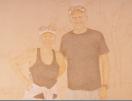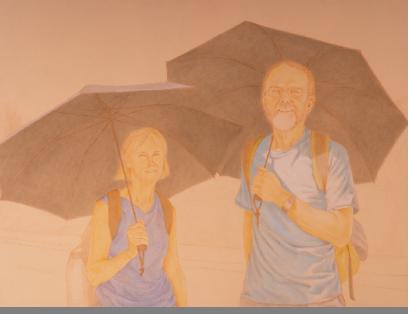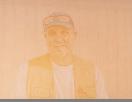|
Larry and Jan:
from British Columbia, on the hot exposed maseta were the only pilgrims I saw with reflective umbrellas. Larry had run a homeless shelter and Jan had worked in special education. We walked several kilometers that Sunday and met several times thereafter.
One of their children, a daughter, was working on developing renewable energy so, of course, I told them about my discovery of an existing energy source not now being tapped. To increase the probability that this energy will someday be utilized, here goes:
Sierra Club Magazine
Dear Sierra,
This letter is about how to use an existing energy source to produce hydro-electric power.
Sierra has had several articles on alternative sources of energy. I’ve come across a way to harness existing hydro energy. I wonder if you’ve heard of it, if anyone is trying to harness this source, or if the Sierra Club could be instrumental in advancing the idea?
The idea: (be patient)
I was at the gym and one of the guys was wearing a SandHogs Union
t-shirt. (The sandhogs are the guys who work on the underground tunnels.) We talked. This sandhog told me that the enormous pipe that carried water from sources in the Catskills to the New York City reservoir system, had for years had a small leak somewhere upstate; that the pressure from the small leak, and the volume of water leaked, had formed a sizable lake and swamp area; that nothing had been done about the leak; that there were at this point no plans to deal with the leak, the tunnel being underground, large, etc.. The sandhog told me there is enough force and volume of water that when the tunnel arrives at the Hudson River the tunnel goes down under the Hudson and back up the other side to continue to the NYC reservoir system. That’s a lot of water and a lot of energy.
So, of course, I asked, “Has anyone thought of harnessing all that power as an alternative energy source?” The sandhog said he’d never heard of such a thing.
When I got home I thought about all that energy and the many miles, some 160, of tunnel and came up with a plan. What if every so many miles you made a bypass tunnel and in that section of tunnel installed an electrical generating system? Could you, as a bonus to transporting water, produce quantities of electricity? The bypass system would allow you to divert the water around the generator when maintenance work needed to be done and would not disturb the flow of water to the reservoir system.
Does this plan sound feasible? I think it would harness large amounts of energy and without building dams that can disturb the eco-systems. And there are probably other areas in the country where this could happen.
What do you think?
Sincerely,
Neal Spitzer
CC: President Obama
Secretary Chu, Dept. of Energy
Environmental Protection Agency
Sen. Schumer
The Nature Conservancy
Appalachian Mountain Club
Adirondack Mountain Club
After several months I recieved a form letter "Thank you for your letter" from the Dept. of Energy and one from the President's office.
I did receive a real letter from the EPA thanking me for my interest and telling me of several localities just beginning to explore this approach to conservation and the generating of power.
I have received no other response.
|
|
|
|
Neal Spitzer, artist, realist painter of people, paintings, portraits, portrait commissions, limited edition archival prints Poetry in Public Places Neal Spitzer, artist, realist painter of people, paintings, portraits, portrait commissions, limited edition archival prints Poetry in Public Places Neal Spitzer, artist, realist painter of people, paintings, portraits, portrait commissions, limited edition archival prints Poetry in Public Places Neal Spitzer, artist, realist painter of people, paintings, portraits, portrait commissions, limited edition archival prints
|
|
|


